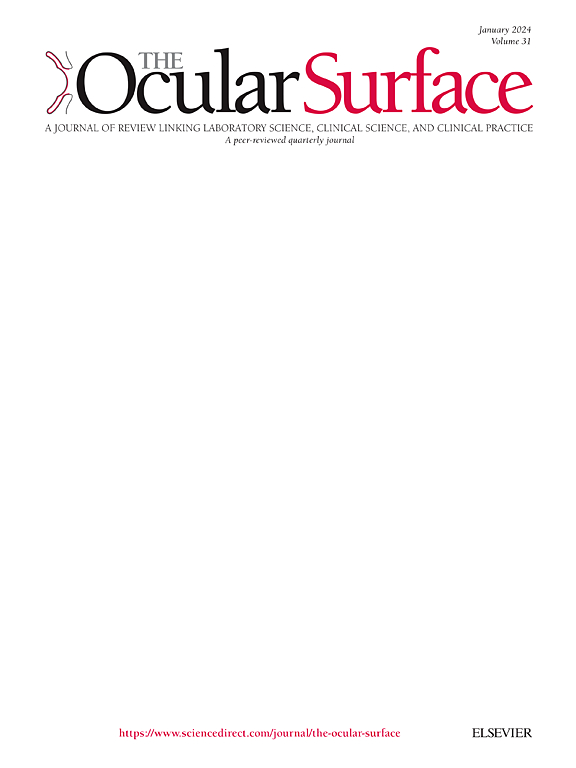Safety of subconjunctival injection of mesenchymal stromal cells in persistent corneal epithelial disease – A phase 1b clinical trial
IF 5.6
1区 医学
Q1 OPHTHALMOLOGY
引用次数: 0
Abstract
Purpose
To investigate the safety and tolerability of subconjunctival injection of three escalating doses of allogeneic bone marrow-derived mesenchymal stromal cells (MSCs) in patients with persistent corneal epithelial defect/disease (PCED).
Design
Prospective single-center open label phase 1b clinical trial.
Participants
Patients with PCED in the setting of neurotrophic keratitis and/or limbal stem cell deficiency.
Methods
A dose escalation study design was used. The first three patients received a subconjunctival injection of 1 × 106 MSCs/50 μL suspension; subsequently, three participants were treated with 1 subconjunctival injection of 3 × 106 MSCs/150 μL; and two participants received 2 subconjunctival injections of 3 × 106 MSCs/150 μl in 2 conjunctival sites.
Main outcome measures
The primary outcome was the safety of the treatment determined on day 28 post-injection. Ocular surface toxicity and other ocular or systemic treatment emergent adverse events (TEAEs) were assessed at 1, 7, 14, 28 and 90 days. Demonstration of safety on day 28 was required before escalating to the next higher dose. Changes in the PCED were also monitored.
Results
Eight participants completed the 90-day study. All 3 doses of subconjunctival MSCs were well tolerated. No participant developed ocular surface toxicity or other ocular or systemic TEAEs. The size of the PCED improved in 5 (63 %) patients; it increased in 2 (25 %) patients; and no progressive improvement was observed with dose escalation.
Conclusion
Subconjunctival administration of MSCs was safe and well tolerated with no systemic or ocular toxicity in patients with PCED. Improvement in epithelial defect size was observed in 63 % of the participants.
结膜下注射间充质间质细胞治疗持续性角膜上皮疾病的安全性- 1b期临床试验
目的:探讨三种递增剂量的同种异体骨髓间充质间质细胞(MSCs)在持续性角膜上皮缺损/疾病(PCED)患者结膜下注射的安全性和耐受性。设计:前瞻性单中心开放标签1b期临床试验。参与者:神经营养性角膜炎和/或角膜缘干细胞缺乏的PCED患者。方法:采用剂量递增研究设计。前3例患者在结膜下注射1 × 106个MSCs/50 μL悬液;随后,3名受试者接受1次结膜下注射3 × 106个MSCs/150 μL;2例患者在2个结膜部位注射3 × 106个MSCs/150μl。主要观察指标:主要观察指标为注射后第28天确定的治疗安全性。在第1、7、14、28和90天评估眼表毒性和其他眼部或全身治疗紧急不良事件(teae)。需要在第28天进行安全性证明,然后再进行下一个更高的剂量。还监测了PCED的变化。结果:8名参与者完成了为期90天的研究。所有3种剂量的结膜下MSCs均耐受良好。没有参与者发生眼表毒性或其他眼部或全身teae。5例(63%)患者PCED大小改善;2例(25%)患者升高;随着剂量的增加,没有观察到进行性改善。结论:在PCED患者中,结膜下给药MSCs是安全且耐受性良好的,无全身或眼部毒性。在63%的参与者中观察到上皮缺陷大小的改善。
本文章由计算机程序翻译,如有差异,请以英文原文为准。
求助全文
约1分钟内获得全文
求助全文
来源期刊

Ocular Surface
医学-眼科学
CiteScore
11.60
自引率
14.10%
发文量
97
审稿时长
39 days
期刊介绍:
The Ocular Surface, a quarterly, a peer-reviewed journal, is an authoritative resource that integrates and interprets major findings in diverse fields related to the ocular surface, including ophthalmology, optometry, genetics, molecular biology, pharmacology, immunology, infectious disease, and epidemiology. Its critical review articles cover the most current knowledge on medical and surgical management of ocular surface pathology, new understandings of ocular surface physiology, the meaning of recent discoveries on how the ocular surface responds to injury and disease, and updates on drug and device development. The journal also publishes select original research reports and articles describing cutting-edge techniques and technology in the field.
Benefits to authors
We also provide many author benefits, such as free PDFs, a liberal copyright policy, special discounts on Elsevier publications and much more. Please click here for more information on our author services.
Please see our Guide for Authors for information on article submission. If you require any further information or help, please visit our Support Center
 求助内容:
求助内容: 应助结果提醒方式:
应助结果提醒方式:


